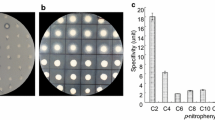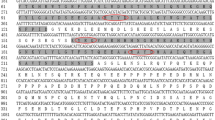Abstract
The transcription activity of the pinoresinol–lariciresinol reductase (PLR) gene of Linum usitatissimum (so-called LuPLR), a key gene in lignan synthesis, was studied by RT-PCR and promoter–reporter transgenesis. The promoter was found to drive transcription of a GUSint reporter gene in the seed coats during the flax seed development. This fitted well with the tissue localization monitored by semi-quantitative RT-PCR of LuPLR expression. Accumulation of the main flax lignan secoisolariciresinol diglucoside was coherent with LuPLR expression during seed development. This three-way approach demonstrated that the LuPLR gene is expressed in the seed coat of flax seeds, and that the synthesis of PLR enzyme occurs where flax main lignan is found stored in mature seeds, confirming its involvement in SDG synthesis.




Similar content being viewed by others
Abbreviations
- GUS:
-
β-Glucuronidase
- HMG:
-
Hydroxyl methylglutaryl
- PLR:
-
Pinoresinol–lariciresinol reductase
- RT-PCR:
-
Reverse transcription-polymerase chain reaction
- SDG:
-
Secoisolariciresinol diglucoside
- X-Gluc:
-
5-Bromo-4-chloro-3-indolyl-β-d-glucuronic acid
References
Abe H, Yamaguchi-Shinozaki K, Urao T, Iwasaki T, Hosokawa D, Shinozaki K (1997) Role of Arabidopsis MYC and MYB homologs in drought- and abscisic acid-regulated gene expression. Plant Cell 9:1859–1868
Adlercreutz H, Mazur W (1997) Phytoestrogens and Western diseases. Ann Med (Helsinki) 29:95–120
Attoumbre J, Hano C, Mesnard F, Lamblin F, Bensaddek L, Raynaud-Le Grandic S, Laine E, Fliniaux MA, Baltora-Rosset S (2006) Identification by NMR and accumulation of a neolignan, the dehydrodiconiferyl alcohol-4-β-d-glucoside, in Linum usitatissimum cell cultures. C R Chimie 9:420–425
Ausubel FM, Brent R, Kingston RE, Moore DD, Seidman JG, Smith JA, Struhl K (1992) DNA detection using the DNA-binding fluorochrome Hoechst H33258. Short protocols in molecular biology, 2nd edn. Wiley, New York, pp A3–A6
Busk PK, Pages M (1998) Regulation of abscisic acid-induced transcription. Plant Mol Biol 37:425–435
Bylund A, Saarinen N, Zhang JX, Bergh A, Widmark A, Johansson A, Lundin E, Adlercreutz H, Hallmans G, Stattin P, Makela S (2005) Anticancer effects of a plant lignan 7-hydroxymatairesinol on a prostate cancer model in vivo. Exp Biol Med (Maywood) 230:217–223
Davin LB, Lewis NG (2003) An historical perspective on lignan biosynthesis: monolignol, allyphenol and hydroxycinnamic acid coupling and downstream metabolism. Phytochem Rev 2:257–288
Davin LB, Wang HB, Crowell AL, Bedgar DL, Martin DM, Sarkanen S, Lewis NG (1997) Stereoselective bimolecular phenoxy radical coupling by an auxiliary (dirigent) protein without an active center. Science 275:362–366
Debeaujon I, Nesi N, Perez P, Devic M, Grandjean O, Caboche M, Lepiniec L (2003) Proanthocyanidin-accumulating cells in Arabidopsis testa: regulation of differentiation and role in seed development. Plant Cell 15:2514–2531
Devic M, Albert S, Delseny M, Roscoe TJ (1997) Efficient PCR walking on plant genomic DNA. Plant Physiol Biochem 35:1–9
Devic M, Guilleminot J, Debeaujon I, Bechtold N, Bensaude E, Koornneef M, Pelletier G, Delseny M (1999) The BANYULS gene encodes a DFR-like protein and is a marker of early seed coat development. Plant J 19:387–398
Doyle JJ, Doyle JL (1990) Isolation of plant DNA from fresh tissue. Focus 12:13–15
Eliasson C, Kamal-Eldin A, Andersson R, Åman P (2003) High-performance liquid chromatographic analysis of secoisolariciresinol diglucoside and hydroxycinnamic acid glucosides in flaxseed by alkaline extraction. J Chromatogr A 1012:151–159
Eulgem T, Rushton PJ, Schmelzer E, Hahlbrock K, Somssich IE (1999) Early nuclear events in plant defence signalling: rapid gene activation by WRKY transcription factors. EMBO J 18:4689–4699
Ford JD, Huang KS, Wang HB, Davin LB, Lewis NG (2001) Biosynthetic pathway to the cancer chemopreventive secoisolariciresinol diglucoside-hydroxymethyl glutaryl ester-linked lignan oligomers in flax (Linum usitatissimum) seed. J Nat Prod 64:1388–1397
Gang DR, Kasahara H, Xia ZQ, Vander Mijnsbrugge K, Bauw G, Boerjan W, Van Montagu M, Davin LB, Lewis NG (1999) Evolution of plant defense mechanisms. Relationship of phenylcoumaran benzylic ether reductase to pinoresinol–lariciresinol reductase and isoflavone reductase. J Biol Chem 274:7516–7527
Hano C, Addi M, Bensaddek L, Crônier D, Baltora-Rosset S, Doussot J, Maury S, Mesnard F, Chabbert B, Hawkins SW, Lainé E, Lamblin F (2006) Differential accumulation of monolignol-derived compounds in elicited flax (Linum usitatissimum) cell suspension cultures. Planta 223:975–989
Harmatha J, Nawrot J (2002) Insect feeding deterrent activity of lignans and related phenylpropanoids with a methylenedioxyphenyl (piperonyl) structure moiety. Entomol Exp Appl 104:51–60
Hattori T, Terada T, Hamasuna S (1995) Regulation of the Osem gene by abscisic acid and the transcriptional activator VP1: analysis of cis-acting promoter elements required for regulation by abscisic acid and VP1. Plant J 7:913–925
Haughn G, Chaudhury A (2005) Genetic analysis of seed coat development in Arabidopsis. Trends Plant Sci 10:472–477
von Heimendahl CBI, Schaefer KM, Eklund P, Sjoeholm R, Schmidt TJ, Fuss E (2005) Pinoresinol–lariciresinol reductases with different stereospecificity from Linum album and Linum usitatissimum. Phytochemistry 66:1254–1263
Higo K, Ugawa Y, Iwamoto M, Korenaga T (1999) Plant cis-acting regulatory DNA elements (PLACE) database. Nucleic Acids Res 27:297–300
Jefferson RA, Kavanagh TA, Bevan MW (1987) GUS fusions: β-glucuronidase as a sensitive and versatile gene fusion marker in higher plants. EMBO J 6:3901–3907
Joshi CP, Zhou H, Huang X, Chiang VL (1997) Context sequences of translation initiation codon in plants. Plant Mol Biol 35:993–1001
Kim MK, Jeon JH, Davin LB, Lewis NG (2002) Monolignol radical–radical coupling networks in western red cedar and Arabidopsis and their evolutionary implications. Phytochemistry 61:311–322
Kitts DD, Yuan YV, Wijewickreme AN, Thompson LU (1999) Antioxidant activity of the flaxseed lignan secoisolariciresinol diglycoside and its mammalian lignan metabolites enterodiol and enterolactone. Mol Cell Biochem 202:91–100
Kogushi S, Ohashi Y, Nakajima K, Arai Y (1990) An improved assay for β-glucuronidase in transformed cells: methanol almost completely suppresses a putative endogenous β-glucuronidase activity. Plant Sci 70:133–140
Kwon M, Davin LB, Lewis NG (2001) In situ hybridization and immunolocalization of lignan reductases in woody tissues: implications for heartwood formation and other forms of vascular tissue preservation. Phytochemistry 57:899–914
Lacoux J, Klein D, Domon JM, Dauchel H, Lamblin F, Alexandre F, Roger D, Balangé AP, David A, Morvan C, Lainé E (2003) Study of a pectin methylesterase using transgenesis with antisens construct and promoter–reporter fusion. In: Visser R (ed) Pectins and pectinases. Kluwer, Dordrecht, pp 183–200
Lescot M, Déhais P, Moreau Y, De Moor B, Rouzé P, Rombauts S (2002) PlantCARE: a database of plant cis-acting regulatory elements and a portal to tools for in silico analysis of promoter sequences. Nucleic Acids Res Database Issue 30:325–327
Lewis NG, Davin LB, Dinkova-Kostova AT, Fujita M, Gang DR (2001) Recombinant pinoresinol–lariciresinol reductase, recombinant dirigent protein, and methods of use. Patent WO 0149833
Madhusudhan B, Wiesenborn D, Schwarz J, Tostenson K, Gillespie J (2000) A dry mechanical method for concentrating the lignan secoisolariciresinol diglucoside in flaxseed. Lebensmittel-Wissenschaft und-Technologie 33:268–275
McCann MJ, Gill CI, McGlynn H, Rowland IR (2005) Role of mammalian lignans in the prevention of prostate cancer. Nutr Cancer 52:1–14
Murashige T, Skoog F (1962) A revised medium for rapid growth and bioassays with tobacco tissue cultures. Physiol Plant 15:473–497
Nishiuchi T, Shinshi H, Suzuki K (2004) Rapid and transient activation of transcription of the ERF3 gene by wounding in tobacco leaves: possible involvement of NtWRKYs and autorepression. J Biol Chem 279:55355–55361
Oomah BD (2001) Flaxseed as a functional food source. J Food Sci Agric 81:889–894
Ralph S, Park JY, Bohlmann J, Mansfield SD (2006) Dirigent proteins in conifer defense: gene discovery, phylogeny, and differential wound- and insect-induced expression of a family of DIR and DIR-like genes in spruce (Picea spp). Plant Mol Biol 60:21–40
Roger D, Lacoux J, Lamblin F, Gaillet D, Dauchel H, Klein D, Balange AP, David A, Laine E (2001) Isolation of a flax pectin methylesterase promoter and its expression in transgenic tobacco. Plant Sci 160:713–721
Sablowski RWM, Moyano E, Culianez-Macia FA, Schuch W, Martin C, Bevan M (1994) A flower-specific Myb protein activates transcription of phenylpropanoid biosynthetic genes. EMBO J 13:128–137
Seidel V, Windhovel J, Eaton G, Alfermann AW, Arroo RRJ, Medarde M, Petersen M, Woolley JG (2002) Biosynthesis of podophyllotoxin in Linum album cell cultures. Planta 215:1031–1039
Sharma SB, Dixon RA (2005) Metabolic engineering of proanthocyanidins by etopic expression of transcription factors in Arabidopsis thaliana. Plant Cell 44:62–75
Shoji T, Winz R, Iwase T, Nakajima K, Yamada Y, Takashi Hashimoto T (2002) Expression patterns of two tobacco isoflavone reductase-like genes and their possible roles in secondary metabolism in tobacco. Plant Mol Biol 50:427–450
Sicilia T, Niemeyer HB, Honig DM, Metzler M (2003) Identification and stereochemical characterization of lignans in flaxseed and pumpkin seeds. J Agric Food Chem 51:1181–1188
Stalberg K, Ellerstom M, Ezcurra I, Ablov S, Rask L (1996) Disruption of an overlapping E-box/ABRE motif abolished high transcription of the napA storage-protein promoter in transgenic Brassica napus seeds. Planta 199:515–519
Tamagnone L, Merida A, Parr A, Mackay S, Culianez-Macia FA, Roberts K, Martin C (1998) The AmMYB308 and AmMYB330 transcription factors from Antirrhinum regulate phenylpropanoid and lignin biosynthesis in transgenic tobacco. Plant Cell 10:135–154
Torres P, Marin JC, Becerra J, Aranda E, Silva M, Cespedes CL (2005) Antioxidant, insecticidal and insect growth regulatory activities of lignans from Araucaria araucana against Spodoptera frugiperda. PNSA Annual Meeting. July 30–August 3, La Jolla, California, USA
Westcott N, Muir A (2003) Flax seed lignan in disease prevention and health promotion. Phytochem Rev 2:401–417
Wiesenborn D, Tostenson K, Kangas N (2003) Continuous abrasive method for mechanically fractionating flaxseed. J Am Oil Chem Soc 80:295–300
Zhu Q, Dabi T, Lamb C (1995) TATA box and initiator functions in the accurate transcription of a plant minimal promoter in vitro. Plant Cell 7:1681–1689
Acknowledgments
We wish to thank J.P. Trouvé (Coopérative Terre de Lin) for the gift of seeds, Institut Technique du Lin for access to the experimental fields, and B. van Droogenbroeck (Ghent University) for seed pictures. Conseil Général d’Eure et Loir, Adittes and Région Centre funded this work. Part of the work was supported by the British Council’s and Alliance Programme (PN 04.078).
Author information
Authors and Affiliations
Corresponding author
Rights and permissions
About this article
Cite this article
Hano, C., Martin, I., Fliniaux, O. et al. Pinoresinol–lariciresinol reductase gene expression and secoisolariciresinol diglucoside accumulation in developing flax (Linum usitatissimum) seeds. Planta 224, 1291–1301 (2006). https://doi.org/10.1007/s00425-006-0308-y
Received:
Accepted:
Published:
Issue Date:
DOI: https://doi.org/10.1007/s00425-006-0308-y




